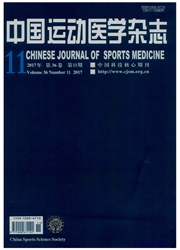

 中文摘要:
中文摘要:
目的:探讨运动性血睾酮降低的胆固醇代谢机制。方法:大鼠在经过5周间歇性负重游泳训练(TA组),造成运动性血睾酮降低的基础上,停训1周(TB组),继续训练1周:维持原负荷(负重5%体重,1组/日,TC组)、负荷量加倍(负重5%体重,2组/日,TD组)、负荷强度增加(负重6%体重,1组/日,TE组),检测大鼠Leydig细胞胆固醇代谢关键环节上的HMG-CoA还原酶、LDL-R、SR-BI及StAR mRNA表达。结果:(1)5周间歇性游泳训练后TA组大鼠血清睾酮显著降低,睾丸Leydig细胞LDL-R mRNA表达量显著升高,SR-BI、HMG-CoA还原酶、StAR mRNA表达量无显著变化。(2)与TA组相比,TB组血清睾酮水平显著升高,LDL-R mRNA表达量显著降低(P〈0.01),SR-BI基因的表达量显著增加(P〈0.01);TC组血清睾酮有进一步降低的趋势,但无统计学意义,LDL-R mRNA表达量显著降低(P〈0.01),SR-BI、HMG-CoA还原酶、StAR mRNA表达量无显著变化;TD组血清睾酮显著降低(P〈0.05),LDL-R、SR-BI、HMG-CoA还原酶和StAR mRNA表达量显著降低(P〈0.01,P〈0.05);TE组血清睾酮有进一步降低的趋势,LDL-R、SR—BI、HMG-CoA还原酶mRNA表达量均显著性降低(P〈0.05,P〈0.01),StAR mRNA表达量未见显著变化。结论:(1)Leydig细胞内胆固醇代谢障碍的发生具有阶段性特征;(2)Leydig细胞内胆固醇代谢障碍不是导致运动性血睾酮降低的起始原因,而细胞内HMG-CoA还原酶、LDL-R、SR-BI、StAR基因表达量降低会加速运动引起的血睾酮降低。
 英文摘要:
英文摘要:
Objective To explore the effects of the one-week swimming with different loads on the gene expressions of HMCr-CoA reductase, LDL-R, SR-BI and StAR in Leydig cells of rats with exercise-induced low serum testosterone. Methods Rats model with low serum testosterone were developed through five-week intermittent swimming training with the load of 5% of body weight (6 days per week, 1 section per day, 6 times of 5-rain swimming per section, with 1-min interval). In the study, following groups were organized: group Sa (5-week control) ; group Sb (6-week control) ; group TA (rats from the model) ; group TB (rats from the model stopped swimming for 1 week) ; group TC (rats from the model continued same swimming for 1 week) ; group TD (rats from the model continued intermittent swimming with the load of 6% of body weight for 1 week, 1 section per day, 6 times of 5-min swimming per section, with 1-min interval) ; group TE (rats from the model continued intermittent swimming with the load of 5% of body weight for 1 week, 2 sections per day, 6 times of 5-rain swimming per section, with 1-min interval). Results (1) As compared with the Sa group, remarkable decrease in serum testosterone, and significant increase in mRNA expression of LDL-R were found in group TA. (2) As compared with the group TA, the level of serum T increased significantly, the LDL-R mRNA expression decreased significantly and the mRNA expression of SR-BI increased significantly in group TB, the mRNA expression of LDL-R was decreased significantly in group TC; The serum T decreased significantly and the mRNA expressions of HMCr-CoA reductase, LDL-R, SR-BI, and StAR decreased significantly in group TD; The serum T decreased further and the mRNA expression of HMCr-GoA reductase, LDL-R and SR-BI decreased significantly in group TE. Conclusion (1) There was a staggered characteristics in the' cholesterol dysbolism in Leydig's cells; (2) Cholesterol dysbolism in Leydig's cells was not always the primary re
 同期刊论文项目
同期刊论文项目
 同项目期刊论文
同项目期刊论文
 期刊信息
期刊信息
